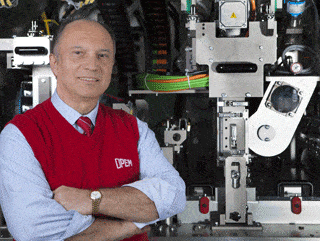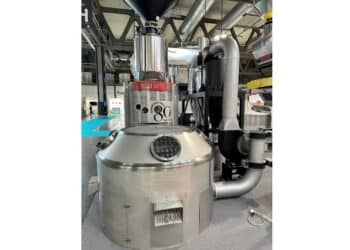For the last 20 years Fabio Binacchi, President of leading capsule-filling machine manufacturers Opem, has been hearing the same sceptical talk of the “trendiness” of single-serve systems, and whether they are here to stay. Two decades onwards, he has to laugh about. Because while that talk continues, the voices are growing fewer and softer, as coffee capsules and pods continue to substantially increase their market share. Estimates put the single-serve as 8 per cent of the total market in terms of volume, but an astounding 25 per cent in terms of value. In developed coffee markets, like the United States and Europe, those market shares are even higher. Clearly, this is no flash in the pan trend. For Binacchi, this comes as no surprise. Having worked in the food packaging industry since 1966, Binacchi is an expert on strategies and innovations in keeping food fresh. Opem specialises in coffee packaging, representing around 80 per cent of the company’s modern business. “Coffee is such a challenging product to keep fresh, because while you need to ensure the carbon dioxide is released as it ages, you also need to limit its exposure to oxygen,” he says. “You can open a 200-gram bag of coffee and after a few days you lose that freshness. After a few weeks, it doesn’t taste anything like it should, it’s hardly coffee.” Having made a career out of dealing with these challenges, when he was first introduced to coffee pods in 1990, and soon afterwards capsules, he quickly saw the potential for single-serve on the market. To open a single portion of coffee and use it instantly, from a packaging perspective, was the ideal solution to ensuring freshness. Catching on to the trend early, Binacchi says Opem was very much a pioneer in the realm of single serve. “I really believed in it, it was just such a fantastic solution to ensuring optimum freshness,” he says. “Someone can use three different kinds of coffee at home, whether it be traditional espresso, or something lighter. They can choose every day a different coffee A, B, or C and not have to open a whole new package.” This ability to have a variety of coffee, without any waste, is one big draw card Binacchi points to in the production of coffee capsules. This is in addition to the obvious benefits from convenience. However, the customer’s appreciation of quality coffee in the cup, he says, is the paramount motivator that will keep customers on single-serve. “The popularity of the technology will always come down to what is sitting in the cup,” he says. “It’s certainly not the price point. Coffee capsules are far more expensive than grabbing a spoonful of coffee out of a package to make coffee in a moka pot.” Binacchi says that the ability of the coffee capsule to conserve the freshness of coffee until right before it’s made is a great win for roasters. With all of their work in sourcing quality beans and perfecting their roast, capsule and pod packaging ensures that the coffee will almost always will consumed exactly as it should. Too easily, he says, those roasting efforts can be lost when a consumer opens a package and leaves it for a few weeks before making their next batch of coffee. It’s in preserving this ideal level of freshness that Opem has focused much of its innovation efforts. As the popularity of coffee capsule manufacturing continues, Opem has released a range of equipment for everyone – from large-scale manufacturers, to those who want to enter the market with minimal investment. Their top machines can fill capsules at an astounding rate of 1400 capsules per minute. For smaller-scale operators who are interested in entering the market with less investment, more affordable machines can fill capsules at 70 per minute. In addition to different scales of operations, roasters have different options in terms of how they choose to enter the single-serve market. They can choose pods or capsules, and in the capsule realm can choose to offer their own proprietal system, link up with an existing system on the market, or create a Nespresso compatible. “We’re seeing everyone look at what the larger roasters are doing, because it’s naturally easiest to follow the giants,” says Binacchi. In terms of innovations, he says this follow-the-leader mentality is largely directing the efforts of these “giants” in keeping out compatible capsules. With many of Nespresso’s patents expiring, and the company choosing to end its legal battles, Nespresso has been fighting compatibles on the technological front, introducing innovations that will try and outwit its competitors. Going back to the taste factor that Binacchi says is the key to single-serve success, he notes it won’t be on the legal or technological front that Nespresso will win the battle – but rather the quality of its coffee.
“Nespresso’s biggest difference has always been its quality. What they’re putting in the capsule is fantastic coffee,” says Binacchi. While the compatible battle may continue, Binacchi does see some potential to resolve a more complex, and unilateral, challenge virtually every single-serve manufacturer is facing. Environmental concerns on the huge waste that coffee capsules create continue, with efforts to make a fully biodegradable capsule still in progress. “Moving to a biodegradable capsule is absolutely necessary. If there is one innovation we should all work towards it’s to protect the environment for future generations,” says Binacchi. He says progress on this front, however, will be limited to making capsules biodegradable without sacrificing the quality taste that has made them so popular. Current plastics have the benefit of a neutral taste, and innovations have to ensure the packaging’s affect on the taste of coffee is kept neutral. Opem is doing its part in terms of research and innovation. The company will be opening a new 13,000-square metre centre in the first half of 2014. The new facility will bring together its production line, that is currently set out over four 1300 square metre facilities, into a single building. The result will be a more productive assembly line, and will also incorporate a research and innovation facility. Binacchi says this research that will help define the future of coffee capsule manufacturing. “We’re seeing a huge demand, and more particular demands like for milk, tea, and generally 360 degree systems that can offer different services,” says BInacchi. “Coffee capsules are the future of our industry.”
Brambati unveils new generation of electric roasters
Italian coffee processing equipment manufacturer Brambati S.p.A. has unveiled its new generation of electric roasters, with a focus on high...





